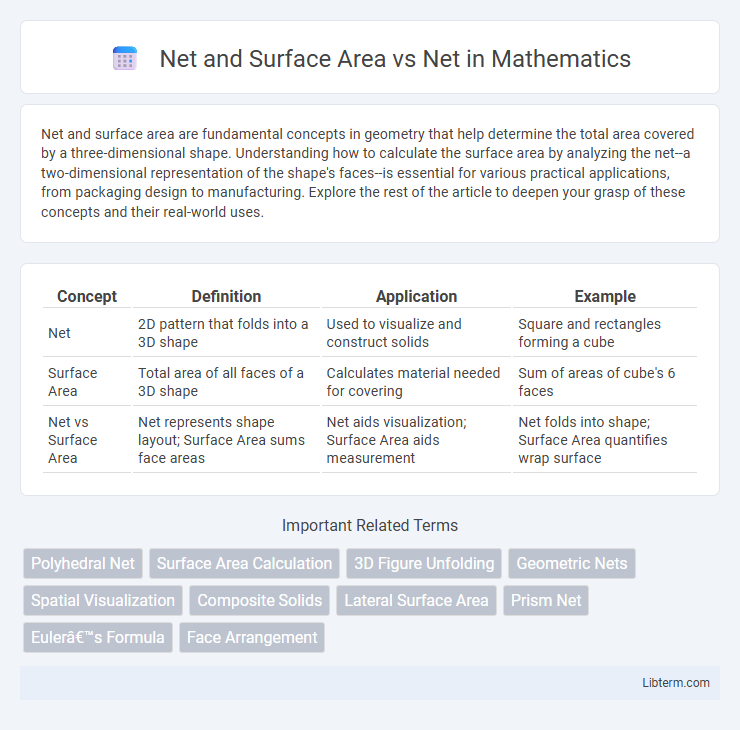Net and surface area are fundamental concepts in geometry that help determine the total area covered by a three-dimensional shape. Understanding how to calculate the surface area by analyzing the net--a two-dimensional representation of the shape's faces--is essential for various practical applications, from packaging design to manufacturing. Explore the rest of the article to deepen your grasp of these concepts and their real-world uses.
Table of Comparison
| Concept | Definition | Application | Example |
|---|---|---|---|
| Net | 2D pattern that folds into a 3D shape | Used to visualize and construct solids | Square and rectangles forming a cube |
| Surface Area | Total area of all faces of a 3D shape | Calculates material needed for covering | Sum of areas of cube's 6 faces |
| Net vs Surface Area | Net represents shape layout; Surface Area sums face areas | Net aids visualization; Surface Area aids measurement | Net folds into shape; Surface Area quantifies wrap surface |
Introduction to Net and Surface Area
A net is a two-dimensional pattern that can be folded to form a three-dimensional shape, providing a clear representation of each face of the solid. Surface area measures the total area covered by all the faces of a 3D object, calculated by summing the areas of the net's individual shapes. Understanding nets helps visualize and compute surface area effectively, especially for complex geometric solids.
Defining a Net in Geometry
A net in geometry is a two-dimensional pattern that can be folded to form a three-dimensional solid, serving as an essential tool to visualize and calculate the surface area of various shapes. Unlike surface area, which measures the total exterior area of a 3D object, a net explicitly displays each face laid out flat, facilitating precise measurement and understanding of the shape's dimensions. Understanding nets allows for accurate computation of surface areas by summing the areas of all polygonal faces represented in the net.
What is Surface Area?
Surface area represents the total area of all the faces or surfaces of a three-dimensional object, measured in square units. Unlike a net, which is a two-dimensional flat layout of all faces of a solid figure before folding, surface area quantifies the actual outer covering when the object is assembled. Calculating surface area is essential in fields such as engineering and architecture for material estimation and design optimization.
Exploring the Relationship Between Net and Surface Area
A net is a two-dimensional pattern that can be folded to form a three-dimensional shape, providing a visual representation of all its surfaces laid flat. Understanding the net allows precise calculation of the surface area by summing the areas of each individual face before assembly. Exploring this relationship enhances spatial reasoning and aids in solving real-world problems involving packaging, construction, and manufacturing.
Step-by-Step Process of Creating Nets
Creating nets involves unfolding a three-dimensional shape into a two-dimensional layout that accurately represents all its faces. Begin by identifying each face of the solid and then flattening it without distortion, ensuring adjacent faces share corresponding edges to maintain connectivity. This step-by-step process facilitates calculating surface area by summing the areas of all faces in the net, providing a clear visual and practical method for surface area determination.
Calculating Surface Area Using Nets
Nets are flat, two-dimensional representations of three-dimensional solids that can be folded to form the shape, making them essential tools for calculating surface area. Surface area is determined by summing the areas of all the faces represented in the net, allowing for precise measurement without complex spatial reasoning. Using nets simplifies the calculation process for cubes, prisms, and pyramids by providing a clear layout of each face's dimensions.
Common Mistakes in Understanding Nets and Surface Area
Common mistakes in understanding nets and surface area often involve confusing a net--a two-dimensional layout of a three-dimensional figure's faces--with the actual surface area measurement, which quantifies the total area covering an object. Students frequently misinterpret how to unfold a net correctly, leading to errors in calculating surface area by missing or overlapping faces. Another typical error is neglecting to apply the correct formulas for each face type, resulting in inaccurate summations of surface areas in geometric solids.
Net vs Surface Area: Key Differences
Net represents a two-dimensional layout of all the faces of a three-dimensional shape, allowing it to be folded into the solid figure. Surface area refers to the total area covered by the outer surfaces of a 3D object, calculated by summing the areas of all its faces. The key difference lies in the net being a flat pattern used for visualization or construction, whereas surface area quantifies the external skin area of the solid.
Practical Applications in Real Life
Understanding net and surface area concepts is crucial in packaging design, as nets help visualize and create accurate three-dimensional boxes from flat materials, optimizing material usage and cost-efficiency. Architects and engineers use surface area calculations to determine the amount of paint, insulation, or materials needed to cover buildings or structures. In manufacturing, accurate nets and surface area measurements ensure components fit together perfectly, reducing waste and improving product durability.
Tips for Teaching Net and Surface Area Concepts
Use hands-on activities like creating 3D shapes from nets to help students visualize how nets fold into solids and understand surface area. Employ interactive tools and visual aids to demonstrate the relationship between each face of a shape and the total surface area. Reinforce learning with real-life examples and practice problems that connect nets to surface area calculation formulas.
Net and Surface Area Infographic

 libterm.com
libterm.com